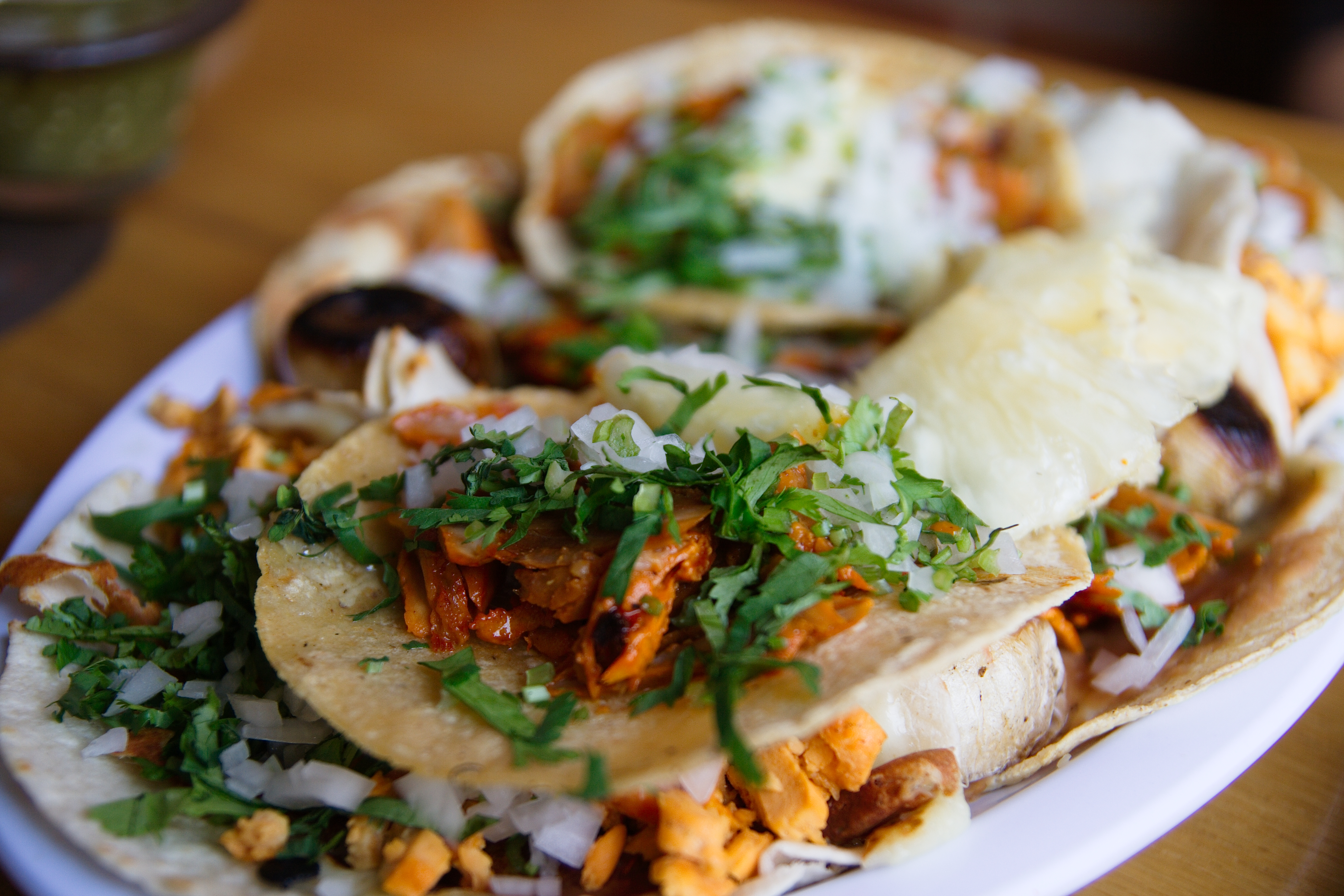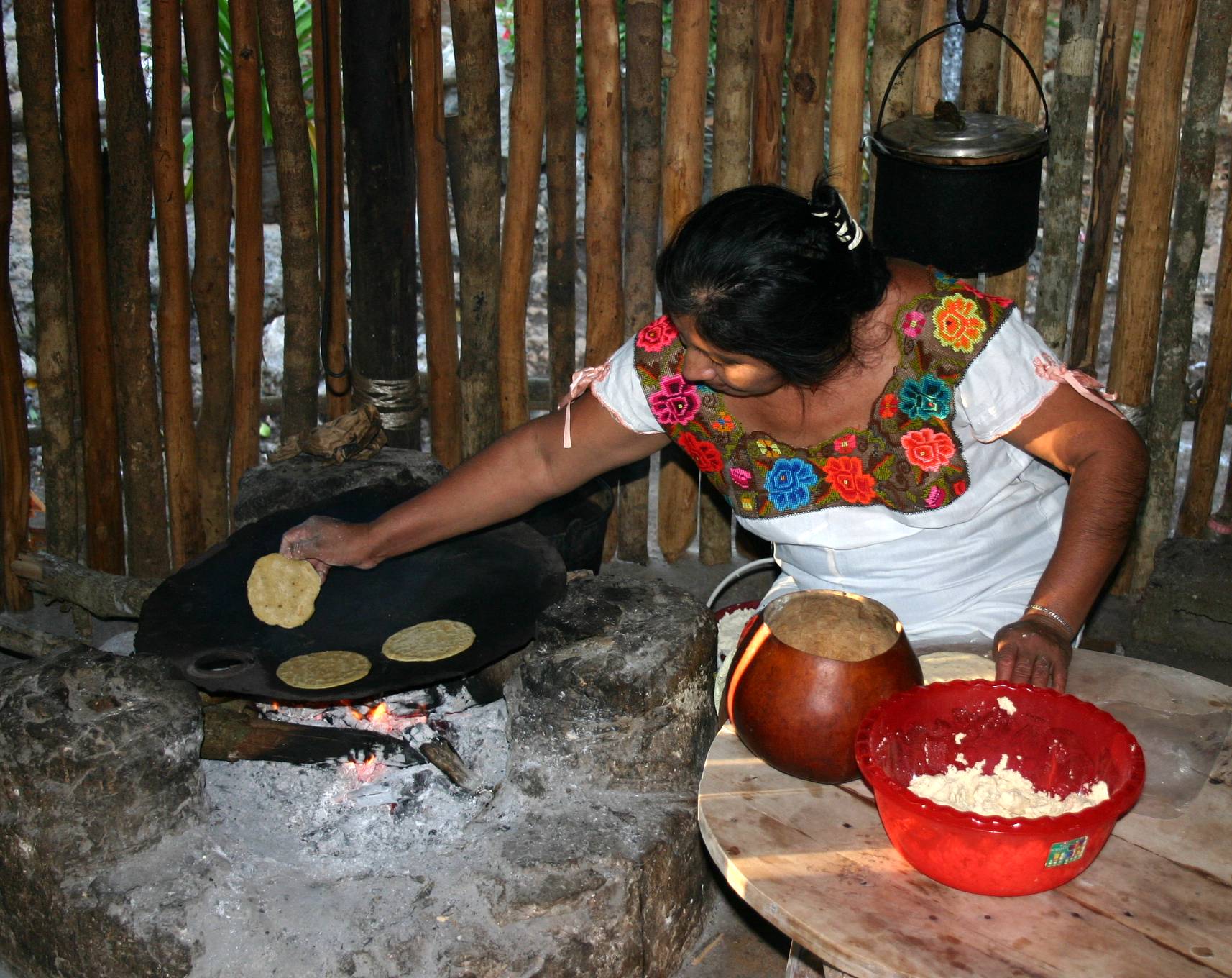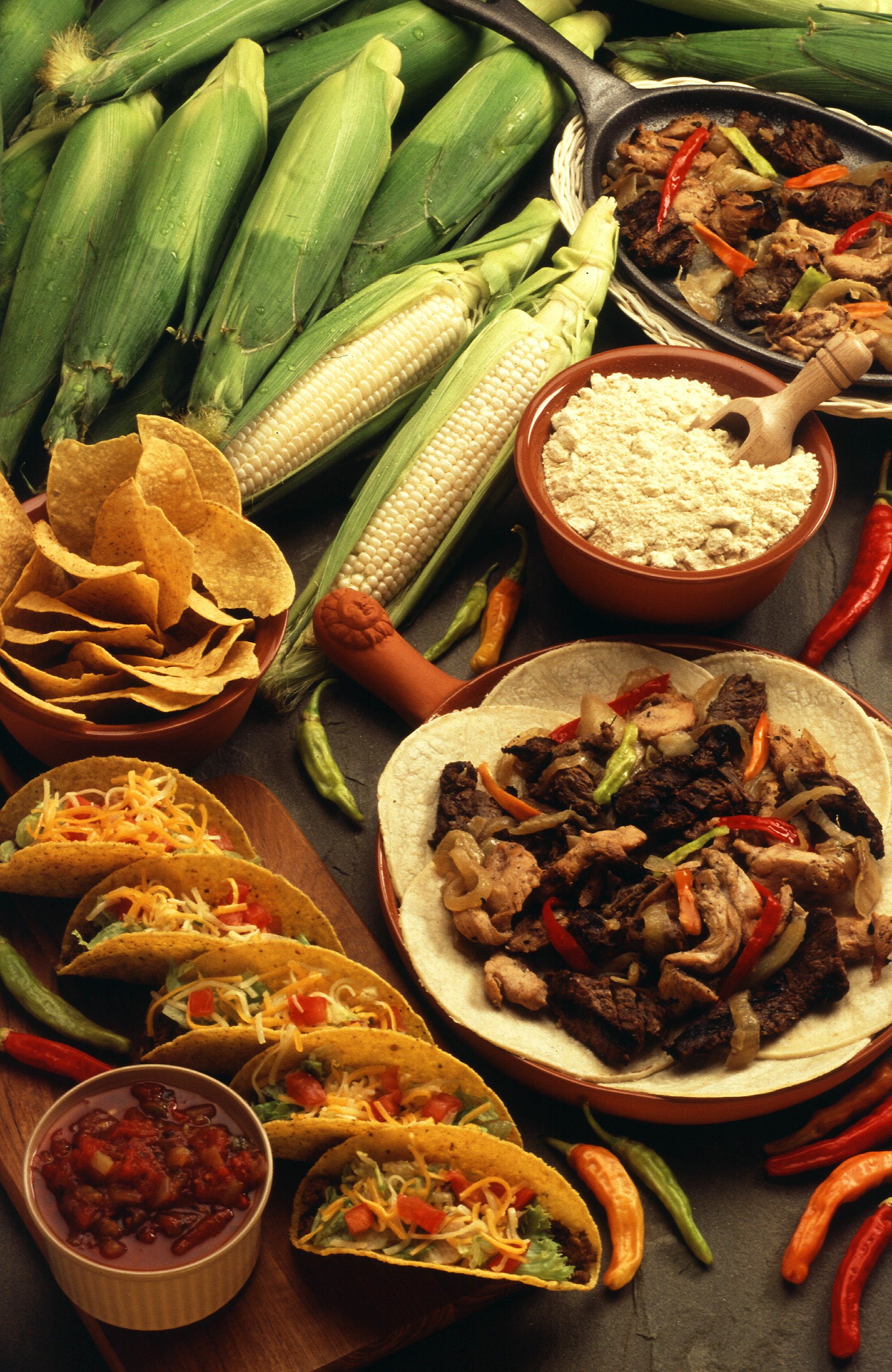|
Taco Rice
is a popular example of modern Okinawan cuisine. It consists of taco-flavored ground beef served on a bed of rice, frequently served with shredded cheese, shredded lettuce, tomato and salsa. Charlie's Tacos, serving tacos in shells made from rice flour, had been established in 1956 as the first "taco place" on Okinawa. Taco rice was created in 1984 by Matsuzo Gibo and introduced at two of his cafes, Parlor Senri and King Tacos, located just a minute from the main gate of Camp Hansen in Kin, Okinawa. Taco rice is a popular dish among U.S. military personnel stationed in Okinawa as lunch or late night food. KFC put it on their menu throughout Japan for a time during the 1990s and Yoshinoya, a nationwide gyūdon restaurant, serves it in the chain's restaurants in Okinawa prefecture. In addition, Taco Bell offers it as a menu option at the chain's restaurant in the Shibuya district of Tokyo. The Tex-Mex flavor is sometimes replaced by the use of soy sauce, mirin and sake. Occ ... [...More Info...] [...Related Items...] OR: [Wikipedia] [Google] [Baidu] |
Taco Rice - Tokyo Area - November 9 2016 - 002
A taco (, , ) is a traditional Mexican food consisting of a small hand-sized corn- or wheat-based tortilla topped with a filling. The tortilla is then folded around the filling and eaten by hand. A taco can be made with a variety of fillings, including beef, pork, chicken, seafood, beans, vegetables, and cheese, allowing for great versatility and variety. They are often garnished with various condiments, such as salsa, guacamole, or sour cream, and vegetables, such as lettuce, onion, tomatoes, and chiles. Tacos are a common form of antojitos, or Mexican street food, which have spread around the world. Tacos can be contrasted with similar foods such as burritos, which are often much larger and rolled rather than folded; taquitos, which are rolled and fried; or chalupas/ tostadas, in which the tortilla is fried before filling. Etymology The origins of the taco are not precisely known, and etymologies for the culinary usage of the word are generally theoretical. ''Taco'' in ... [...More Info...] [...Related Items...] OR: [Wikipedia] [Google] [Baidu] |
Yoshinoya
is a Japanese multinational fast food chain, and the second-largest chain of '' gyūdon'' (beef bowl) restaurants. The chain was established in Japan in 1899. Its motto is "Tasty, low-priced, and quick". Etymology and logo The kanji 吉 (''yoshi'') means "luck" in Japanese, the kanji 野 (''no'') means " field", and the kanji 家 (''ya'') means "house". The founder of the company, Eikichi Matsuda (松田栄吉), was from the former town of Yoshino (吉野町) in Osaka Prefecture, and a belief predominates that Yoshino is the origin of the name. In Japan, the nickname of the restaurant is "''yoshigyū''" (吉牛), which is an abbreviation of ''Yoshinoya no gyūdon'' (吉野家の牛丼, Yoshinoya's gyūdon). The logo of Yoshinoya resembles a bull horn, and was invented by Yoshinoya's founder Eikichi Matsuda. The idea of the bull horn was derived from the initial letter of Yoshinoya's English name, "Y". The rope surrounding the horn represents a in Japanese sumo-wrestling, ... [...More Info...] [...Related Items...] OR: [Wikipedia] [Google] [Baidu] |
Japanese Rice Dishes
Japanese may refer to: * Something from or related to Japan, an island country in East Asia * Japanese language, spoken mainly in Japan * Japanese people, the ethnic group that identifies with Japan through ancestry or culture ** Japanese diaspora, Japanese emigrants and their descendants around the world * Japanese citizens, nationals of Japan under Japanese nationality law ** Foreign-born Japanese, naturalized citizens of Japan * Japanese writing system, consisting of kanji and kana * Japanese cuisine, the food and food culture of Japan See also * List of Japanese people * * Japonica (other) * Japonicum * Japonicus * Japanese studies Japanese studies ( Japanese: ) or Japan studies (sometimes Japanology in Europe), is a sub-field of area studies or East Asian studies involved in social sciences and humanities research on Japan. It incorporates fields such as the study of Japan ... {{disambiguation Language and nationality disambiguation pages ... [...More Info...] [...Related Items...] OR: [Wikipedia] [Google] [Baidu] |
Tortilla
A tortilla (, ) is a thin, circular unleavened flatbread originally made from maize hominy meal, and now also from wheat flour. The Aztecs and other Nahuatl speakers called tortillas ''tlaxcalli'' (). First made by the indigenous peoples of Mesoamerica before colonization, tortillas are a cornerstone of Mesoamerican cuisine. Corn tortillas in Mesoamerica are known from as early as 500 BCE. Varieties Corn tortilla Tortillas made from nixtamalized maize meal—masa de maíz— are the oldest variety of tortilla. They originated in Mexico and Central America, and remain popular throughout the Americas. Peoples of the Oaxaca region in Mexico first made tortillas at the end of the Villa Stage (1500 to 500 BC). Towards the end of the 19th century, the first mechanical utensils for making tortillas, called tortilla presses, tortilleras, or tortilladoras, were invented and manufactured in Mexico. Wheat tortilla Europeans introduced wheat and its cultivation to the Ameri ... [...More Info...] [...Related Items...] OR: [Wikipedia] [Google] [Baidu] |
Sake
Sake, also spelled saké ( ; also referred to as Japanese rice wine), is an alcoholic beverage of Japanese origin made by fermenting rice that has been polished to remove the bran. Despite the name ''Japanese rice wine'', sake, and indeed any East Asian rice wine (such as huangjiu and cheongju), is produced by a brewing process more akin to that of beer, where starch is converted into sugars which ferment into alcohol, whereas in wine, alcohol is produced by fermenting sugar that is naturally present in fruit, typically grapes. The brewing process for sake differs from the process for beer, where the conversion from starch to sugar and then from sugar to alcohol occurs in two distinct steps. Like other rice wines, when sake is brewed, these conversions occur simultaneously. The alcohol content differs between sake, wine, and beer; while most beer contains 3–9% ABV, wine generally contains 9–16% ABV, and undiluted sake contains 18–20% ABV (although this is often ... [...More Info...] [...Related Items...] OR: [Wikipedia] [Google] [Baidu] |
Mirin
is a type of rice wine and a common ingredient in Japanese cooking. It is similar to sake but with a lower alcohol content and higher sugar content. The sugar content is a complex carbohydrate that forms naturally during the fermentation process; no sugars are added. The alcohol content is further lowered when the liquid is heated. Three types of mirin are common. The first is ''hon mirin'' (literally: true mirin), which contains about 14% alcohol and is produced by a 40 to 60 day mashing (saccharification) process. The second is ''shio mirin'' (literally: salt mirin), which contains a minimum of 1.5% salt to prevent consumption in order to avoid alcohol tax. The third is ''shin mirin'' (literally: new mirin), or ''mirin-fu chomiryo'' (literally: mirin-like seasoning), which contains less than 1% alcohol, yet retains the same flavor. In the Edo period, mirin was consumed as ''amazake''. O-toso, traditionally consumed for the Japanese New Year, can be made by soaking a spic ... [...More Info...] [...Related Items...] OR: [Wikipedia] [Google] [Baidu] |
Soy Sauce
Soy sauce (also called simply soy in American English and soya sauce in British English) is a liquid condiment of Chinese origin, traditionally made from a fermented paste of soybeans, roasted grain, brine, and ''Aspergillus oryzae'' or '' Aspergillus sojae'' molds. It is considered to contain a strong umami taste. Soy sauce in its current form was created about 2,200 years ago during the Western Han dynasty of ancient China, and it has spread throughout East and Southeast Asia where it is used in cooking and as a condiment. Use and storage Soy sauce can be added directly to food, and is used as a dip or salt flavor in cooking. It is often eaten with rice, noodles, and sushi or sashimi, or can also be mixed with ground wasabi for dipping. Bottles of soy sauce for salty seasoning of various foods are common on restaurant tables in many countries. Soy sauce can be stored at room temperature. History East Asia China Soy sauce (, ) is considered almost as old as ... [...More Info...] [...Related Items...] OR: [Wikipedia] [Google] [Baidu] |
Tex-Mex
Tex-Mex cuisine (from the words ''Texan'' and ''Mexican'') is an American cuisine that derives from the culinary creations of the ''Tejano'' people of Texas. It has spread from border states such as Texas and others in the Southwestern United States to the rest of the country. Tex-Mex is most popular in Texas and neighboring areas, especially nearby states in both the US and Mexico. It is a subtype of Southwestern cuisine found in the American Southwest. Common dishes Some ingredients in Tex-Mex cuisine are also common in Mexican cuisine, but others not often used in Mexico are often added. Tex-Mex cuisine is characterized by its heavy use of shredded cheese, beans, meat (particularly chicken, beef, and pork), chili peppers, and spices, in addition to flour ''tortillas''. Sometimes various Tex-Mex dishes are made without the use of a ''tortilla''. A common example of this is the "fajita bowl", which is a ''fajita'' served without a soft ''tortilla''. Generally, cheese p ... [...More Info...] [...Related Items...] OR: [Wikipedia] [Google] [Baidu] |
Shibuya
Shibuya (wikt:渋谷, 渋谷wikt:区, 区 ''Shibuya-ku'') is a Special wards of Tokyo, special ward in Tokyo, Japan. As a major commercial and finance center, it houses two of the busiest railway stations in the world, Shinjuku Station (southern half) and Shibuya Station. As of April 1, 2022, it has an estimated population of 228,906 and a population density of 15,149.30 people per km2 (39,263.4/sq mi). The total area is 15.11 km2 (5.83 sq mi). The name "Shibuya" is also used to refer to the shopping district which surrounds Shibuya Station. This area is known as one of the fashion centers of Japan, particularly for young people, and as a major nightlife area. History Heian to Edo period Shibuya was historically the site of a castle in which the Shibuya family resided from the 11th century through the Edo period. Following the opening of the Yamanote Line in 1885, Shibuya began to emerge as a railway terminal for southwestern Tokyo and eventually as a major commercial and ... [...More Info...] [...Related Items...] OR: [Wikipedia] [Google] [Baidu] |
Taco Bell
Taco Bell is an American-based chain of fast food restaurants founded in 1962 by Glen Bell (1923–2010) in Downey, California. Taco Bell is a subsidiary of Yum! Brands, Inc. The restaurants serve a variety of Mexican-inspired foods, including tacos, burritos, quesadillas, nachos, novelty and speciality items, and a variety of "value menu" items. , Taco Bell serves over customers each year, at 7,072 restaurants, more than 93 percent of which are owned and operated by independent franchisees and licensees. PepsiCo purchased Taco Bell in 1978, and later spun off its restaurants division as Tricon Global Restaurants, which later changed its name to Yum! Brands. History Taco Bell was founded by Glen Bell, an entrepreneur who first opened a hot dog stand called Bell's Drive-In in San Bernardino, California, in 1948. Bell watched long lines of customers at a Mexican restaurant called the Mitla Cafe, located across the street, which became famous among residents for its hard ... [...More Info...] [...Related Items...] OR: [Wikipedia] [Google] [Baidu] |
Gyūdon
, also known as , is a Japanese dish consisting of a bowl of rice topped with beef and onion simmered in a mildly sweet sauce flavored with ''dashi'' (fish and seaweed stock), soy sauce and ''mirin'' (sweet rice wine). It may sometimes also be served with toppings such as raw or soft poached eggs, Welsh onions (''negi''), grated cheese or kimchi. A popular food in Japan, it is commonly eaten with ''beni shōga'' (pickled ginger), ''shichimi'' (ground chili pepper), and a side dish of miso soup. History After the arrival of Buddhism in Japan in the 6th century, consumption of meat became rare in Japanese culture (especially those of four-footed animals such as beef or pork) and in many cases frowned upon, both for religious and practical reasons. It was only after the Meiji Restoration in 1868 and the subsequent westernization of the country that meat began to be widely eaten. ''Gyūdon'' is considered to be derived from ''gyūnabe'' (牛鍋), a beef hot pot originating ... [...More Info...] [...Related Items...] OR: [Wikipedia] [Google] [Baidu] |
Kin, Okinawa
is a town located in Kunigami District, Okinawa Prefecture, Japan. In October 2016, the town had an estimated population of 11,259 and a density of 300 persons per km2. The total area of Kin is . 59% of the land area of Kin remains under control of the United States military, the highest percentage of any municipality in Okinawa Prefecture. The population of the town is concentrated on a strip of land on the coast of Kin Bay. Kin is home to Camp Hansen, a military base of the United States Marines, as well as other smaller military installations. Kin is home to the Dragon Brand of awamori, with a Buddhist shrine built in 1522, and a 270-meter natural cave known as Kin Shonyudo that doubles as both a place of worship and a cellar for aging bottles of the drink. Kin is also claimed to be the origin of taco rice, a dish emblematic of modern Okinawan cuisine. Geography Kin is located at the middle of Okinawa Island, and is roughly triangular in shape. The town is roughly lo ... [...More Info...] [...Related Items...] OR: [Wikipedia] [Google] [Baidu] |









